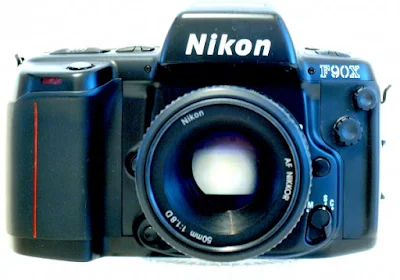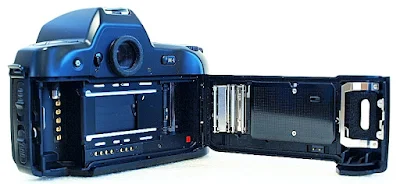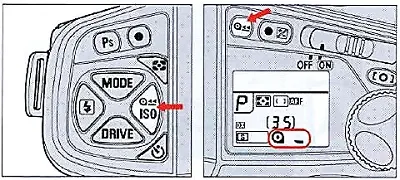The Vintage Enthusiast: An advanced autofocus 35mm SLR film camera, Nikon's best and most expensive amateur model.
The Nikon F90X (N90S in the United States), an advanced autofocus 35mm SLR film camera, was the best and most expensive of Nikon's semi-professional 35mm SLR series when it was first launched in 1964. While its used price may be as low as it is today, there is no denying that the F90X/N90S is still the camera it was set out to be, and is still a highly selectable asset for film photography enthusiasts who are keen to work with Nikon autofocus SLR film cameras.
Introduced as an upgrade to the Nikon F90/N90 (1992 to 2001), the F90X was noted, among others, for its fast autofocus speed when compared to previous Nikon models, more accurate autofocus even in low light conditions, shutter speed adjustments in thirds of a stop, increased frame rate, with a built that retains the same tough metallic chassis under its rubber grip and industrial-strength outer plastic casing of its predecessor, and better weather sealing.
The F90X is fitted with an electronically-controlled vertical-travel focal-plane shutter with a speed range from 30 seconds to 1/8000 second (in 1/3 stops) in single-frame or continuous shooting modes, motorized film transport, automatically activated focus tracking, three built-in exposure meters (Matrix, Center-Weighted, and Spot), wide and spot selectable autofocus areas, with autofocus and electronic rangefinder manual focusing modes./p>
The F90X/N90S accepts DX-coded film ISO speed range from 60 to 2500 and has a manual setting for film ISO speed rating from 6 to 6400, the metering range (at ISO 100 with 1.4 lenses) is EV -1 to EV 21 for Matrix and Center-Weighted, and EV 3 to EV 21 for Spot metering.
Exposure modes include Programmed Auto (Auto Multi-Program and Vari-Program), Shutter Priority Autom Aperture-Priority Auto, and Manual. Vari-program modes include Portrait, Portrait with Red-Eye Reduction, Hyperfocal, Landscape, Silhouette, Sports, and Close-Up.
Is The Nikon n90s * F90X The Most Underrated SLR On Earth???
I've shot with the Nikon n90s/f90x for about 6 months now. I always shoot with two film cameras oon portrait sessions, the Nikon f100 and the Nikon n90s. I'v...
Flash X-sync in Program and Aperture mode on the F90X is from 1/60 to 1/250 second in normal sync or 30 sec to 1/250 in slow sync. In shutter-priority and manual modes, the shutter fires at the speed set, and 1/250 second for speeds from 1/250 to 1/8000 second.
Design and Built
The F90X is built out of a tough metallic chassis under its rubber grip and industrial-strength outer plastic casing. Aside from the rubberized film back which is susceptible to degradation, the camera comes with several seals that protect the camera from dust and moisture, which is good enough for a spatter of light rain. The film back, for example, is secured with a double squeeze tab which must be pressed at the same time to release the film back latch mechanism.
A functional go for the F90X as a choice for film camera enthusiasts is the use of standard corner-store type AA batteries to power the camera's operations. The ease and availability of these power pack options can be used to power the camera anywhere from 14 (AA-type Manganese) to 50 (AA-type Alkaline) 36-exposure film rolls.
Basic Camera Features
While it may take a while for you to get deep into the plethora of functions available on the F90X, rest assured that they all point to a very functional and logical layout. Most configurable functions are two-handed operations, one to press the function button, and the other to toggle the Command Input Control Dial for the right selection setting./p/>
On the front plane of the camera, aside from the raised lens housing mount and molded hand-grip, are the DoF (Depth of Field) preview and AF-L (Auto Focus Lock) buttons located on the left side of the mount, and on the right, Flash Sync socket and 10-pin Remote Terminal, Lens Release Lock, and Focus Mode Selector button.
On the top plane, set right to the left edge, is a 4-button clover pad for Mode (for Program, Shutter Priority, Aperture Priority, and Manual), ISO (when DX-coded film is loaded the camera automatically sets the ISO rating), Flash (there is no built-in flash), and Drive (for continuous or single frame) selections.
On the top right corner of the pad is the Metering System toggle, and on the lower right, is the Self-Timer toggle switch. The left button of the grouped pair of toggle switches above the clover pad controls the camera's Vari-Program (Ps) mode, while the green dot button is used to Reset the camera back to its default settings.
To the right of the pentaprism hump, which has a hot shoe installed, from front to back, are the Shutter Release button located on the top-left edge of the hand grip, a pair of grouped pair of toggle buttons switches for Film Rewind and Exposure Compensation, Power On/Off slide switch, LCD panel, Focus Area button, and Command Input Control Dial.
On the back, along the back of the top plane are the viewfinder/LCD illumination button, Eyepiece Shutter lever, viewfinder eyepiece, and AE-L (Auto Exposure Lock) lever.
The interchangeable hinged film back comes with a film cartridge confirmation window, and if fitted, an LCD panel and switches for QD (Quartz Date) functions, and a screw-in panel cover for the QD panel batteries. Incidentally, an MF-26 Data Back is the solution to the rubber skin degradation of the F90X's standard film back.
Located on the bottom plate are the battery holder cover and tripod socket.
The film box of the F90X is similar to what is seen on SLR film cameras, with the DX-enabled film canister chamber located on the far left, followed by the shutter window, forward sprocket gear, and take-up spool. Film forward, however, is automatic. The film tab is extended to the red mark on the spool side of the film back and tensioned before the film back is closed.
Film Loading and Rewind
Film loading is the standard manual procedure of opening the film back, slotting the film canister into the canister chamber on the left of the film box, pulling the film tab across the shutter window, aligning the forward sprocket gear, slotting the film tab end into one of the multi-slot slits of the take-up spool, checking that the film is properly tensioned before closing the film back. Forwarding the unexposed part of the film roll to frame 1 is automatic. Do this by releasing the shutter fully.
The film advance stops automatically at the end of the roll. To rewind, press the two red-colored rewind icons, one located on the cloverleaf selector dial on the left of the camera top, and the other located above the LCD display on the right of the camera top, simultaneously.
The film is fully rewound and can be removed from the camera when the action stops.
Viewfinder Readout
The F90X is fitted with an advanced B-type Briteview (interchangeable with the E-type clear Matt/Fresnel) screen with 92% image coverage as standard. The clear matt field display includes etched elements for Wide-Area focus brackets, a 12mm reference circle for Center-Weighted Metering, 3mm reference for Spot Metering/and Spot Area Focus.The horizontal display bar located under the viewscreen includes an information display for the Focus Area, focus indicators with In-Focus Rangefinder Spot and Autofocus Indicator Arrows, Exposure Mode/Flexible Program, Shutter Speed, Aperture, electronic Analog Display/Exposure Difference, Frame Counter/Vari-Program/Compensation Value/amount of Exposure Difference, Exposure Compensation, Flash Recommended/Flash Ready Light.
LCD Panel Info
The LCD panel, located to the right of the pentaprism hump, functions as the command control center of the camera with a display of the camera's shooting information.The display of graphic icons and numerals includes information on Focus Area, Exposure Mode/Flexible Program, Metering System, Film Speed Setting mode, Exposure Compensation, Shutter Speed, Autofocus, Aperture, Release/Focus Priority, Flash Sync mode, Red-Eye Reduction, PC connection, Custom, Battery, Film Advance mode, Frame Counter/Vari-Program/ISO Speed/Self-Timer duration/Compensation Value, Film Loading, Film Advance, and Rewind, and Self-Timer.
Metering Modes
The F90X is fitted with three exposure metering modes - Matrix Metering, Center-Weighted Metering, and Spot Metering. To select the options, press the Metering System button, and joggle the Command Input Control Dial for the right selection.- Matrix Metering - The ideal for fast shoots in any exposure program. 3D matrix metering (scene brightness, scene contrast, focussed subject distance) is automatically activated when the camera is mounted with Nikkor D lenses. Matrix metering can be used only with CPU-based Nikkor lenses (AF Nikkor and Ai-P lenses).
- Center-Weighted Metering - Ideal when shooting image frames with a base exposure on a specific area of the screen. 75% of the metering is taken from the 12mm reference circle of the viewfinder.
- Spot Metering - Used for selective exposure control on specific spots of the image frame. Almost 100% of metering is taken from the 3mm spot-metering/spot area focus circle of the viewfinder.
Exposure Program Modes
The F90X offers two types of programmed exposure modes - Auto Multi-Program, and Vari-Program, as well as Shutter-Priority Auto, Aperture-Priority Auto, and Manual Exposure modes. To select the PASM option, press the Mode button on the clover-pad, and joggle the Command Input Control Dial for the right selection.- Auto-Multi Program - Used for general shooting conditions.
- Vari-Program - Selectable between Portrait Program, Portrait Program with Red-Eye Reduction, Hyperfocal Program, Landscape Program, Silhouette Program, Sports Program, and Close Up Program.
- Shutter-Priority Auto - Operates only with AF Nikkor and Nikkor AI-P lenses.
- Aperture-Priority Auto - Works generally with all Nikkor lenses.
- Manual Exposure.
Autofocus Modes
The autofocus system on the F90X works in two modes, and in both instances, autofocus tracking is activated automatically and remains activated as long as the shutter button is pressed lightly.- Single Servo AF with Focus-Priority - In single-frame shooting mode (focus mode selector set to 'S'), the shutter releases only when the subject is in focus, or expected to be in focus for the moving subject, confirmed by the focus indicator LEDs in the viewfinder display.
- Continuous Servo AF with Release-Priority - In continuous frame shooting (focus mode selector set to 'C'), the shutter releases when pressed, regardless of whether the subject is in focus or not.
Manual Focusing Mode
The Manual Focus Mode (focus mode selector set to 'M'), which allows you to make changes to both the aperture and shutter speed setting, is used when AF Nikkor lenses are operated manually, or when the camera is used with legacy Ai and Ai-S Nikkor lenses.Focusing is done with the aid of the electronic rangefinder, with focus confirmation indicated by the Green focus indicators LED on the viewfinder display bar. The electronic rangefinder is activated when the shutter release button is pressed slightly, and the pressure is maintained while focusing.
Exposure Compensation
With the F90X's metering ability, exposure compensation is not a technique that you have to use often. In preference, you can always use the AE-L function to retain the exposure reading for the spot- or center-weighted image frames, use manual exposure mode for precise metering, or the All-Mode Exposure Bracketing function if you have an MB26 back attached.
If you still need the use of the function, set it up by first pressing the exposure compensation button, and toggle the compensation value with the Command Input Control Dial. Compensation values are -5 to +5 EV in 1/3 steps.
Self-Timer
The self-timer delay on the F90X can be set from 2 to 30 seconds in one-second increments. Start by first pressing the self-timer button and use the Command Input Control Dial to set the delay duration.
To execute, first touch the shutter button slightly to confirm focus and exposure, and next, press down on the self-timer button and release the shutter. The self-timer LED display will light up only in the final 2 seconds of the delay.
Press the shutter release during the delay to cancel the execution.
Lens Compatibility
The F90X is a Nikon F-mount camera. It is completely compatible with Nikkor lenses of the same production period. Newer G lenses without aperture rings will only function fully when used with shutter priority and program modes. The lenses will only work at minimum aperture under manual or aperture priority shooting modes.
Manual focus Nikkor Ai and Ai-S lenses will work on the F90X with only center-weighted and spot metering functions. Focusing can be done with the aid of the electronic rangefinder, denoted by a pair of arrows and a green in-focus dot, on the bottom left-hand corner of the viewfinder display.
Battery
The F90X requires a set of 4 AA-sized Alkaline, rechargeable NiCd, or Manganese battery cells to power its operations. Under normal operating conditions, the cells can power the camera for up to 50 (Alkaline), 40 (rechargeable NiCd), or 15 (Manganese) 36-exposure film rolls. Under cold weather conditions, the number of film rolls per set of batteries will decrease exponentially.
Camera Body Weight
The F90X camera's body weight is 755 grams without batteries.
F90X / N90S Instructions
Click on the link to download the PDF version of the Nikon F90X Instruction Manual or the Nikon N90S Instruction Manual, with many thanks, from Butkus.
In Use
The F90X is definitely a delight to have and fun to use. A very bright and clear viewfinder with the finest of etched lines for the spot-meter, autofocus bracket, and center-weighted metering circle, and a well-organized minimal functions display (not at all cluttered as seen in the description section above), and with Nikon's lightweight AF Nikkor lenses, is all it needs to get you going.
The camera holds firm and steady in your hands and has a tough bakelite body, strong stainless-steel lens mount, rugged internals, and a fairly ergonomic design. Nothing seems to stand in the way of you getting the most out of the creative functions of the camera. Controls are easy to use, set, and manipulate, and for those who are coming back to film with the Nikon DSLR experience, all these functionalities are all but familiar.
Mechanicals are smooth, focusing is fast, metering is mesmerizing, and exposures are perfect, but none too quiet with the AF motor, shutter actuation, mirror flap, and no mirror lockup. Though grossly underrated, and overshadowed by later models, the F90X is still one of the best AF SLR film cameras for film photography enthusiasts from Nikon, available at prices far below expectations.
Recommendation
The recommended option, is an F90X with an MF-25 or MF-26 data back, with no film back rubber skin degradation.





























No comments:
Post a Comment